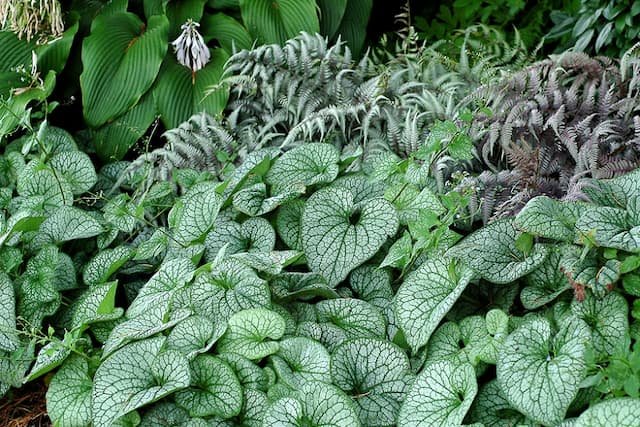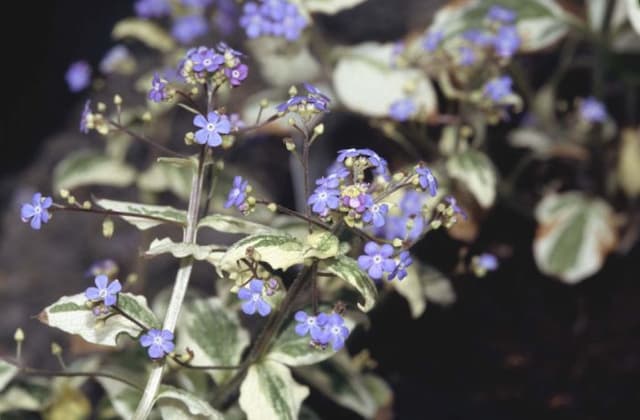Lungwort Pulmonaria 'Stillingfleet Meg'

ABOUT
Pulmonaria 'Stillingfleet Meg' is distinguished by its attractive foliage and charming flowers. This plant boasts soft, hairy leaves that are largely green but adorned with silver spots and splotches, creating a dappled effect that is both eye-catching and soothing. In spring, the plant produces clusters of delicate flowers that typically emerge in shades of pink and mature into a striking blue hue as they age. The contrast between the young pink and mature blue flowers can be seen concurrently, providing a delightful mix of colors that adds to the plant's ornamental appeal. The tubular shape of the flowers is particularly enticing to pollinators like bees. The overall impression of Pulmonaria 'Stillingfleet Meg' is one of a gentle yet sophisticated presence in a garden, which can enliven shaded areas with its variegated leaves and two-tone blossoms. Its lush, mound-forming habit makes it an excellent ground cover or border plant, contributing to a cottage garden aesthetic or serving as a textured backdrop to other shade-loving perennials.
About this plant
 Names
NamesFamily
Boraginaceae.
Synonyms
Lungwort, Bethlehem Sage, Jerusalem Cowslip, Soldiers and Sailors.
Common names
Pulmonaria 'Stillingfleet Meg'.
 Toxicity
ToxicityTo humans
Lungwort (Pulmonaria 'Stillingfleet Meg') is generally considered non-toxic to humans. There are no widely recognized symptoms of poisoning from ingesting this plant as it is not classified as poisonous. However, it's always wise to avoid eating any plant material unless it is known to be safe and is intended for culinary use.
To pets
Lungwort (Pulmonaria 'Stillingfleet Meg') is also generally considered non-toxic to pets. There are no specific symptoms associated with the poisoning of pets from this plant because it is not recognized as being poisonous to domestic animals. As with humans, to be safe, pets should not be allowed to ingest plants that are not confirmed to be safe for animal consumption.
 Characteristics
CharacteristicsLife cycle
Perennials
Foliage type
Semi-deciduous
Color of leaves
Variegated
Flower color
Mixed
Height
1 feet (30 cm)
Spread
1 feet 2 inches (35 cm)
Plant type
Herb
Hardiness zones
3
Native area
Europe
Benefits
 General Benefits
General Benefits- Aesthetic Appeal: Pulmonaria 'Stillingfleet Meg', commonly known as Lungwort, offers attractive foliage and flowers, enhancing garden beauty.
- Shade Tolerance: Lungwort is well-suited for shaded areas where other plants might not thrive, making it a great choice for woodland gardens.
- Seasonal Interest: With early spring flowers and unique spotted leaves, Lungwort provides visual interest throughout multiple seasons.
- Pollinator-Friendly: The blooms attract bees, butterflies, and other pollinators, supporting local ecosystems and biodiversity.
- Low Maintenance: Lungwort is generally easy to grow and does not require extensive care, making it ideal for casual gardeners.
- Ground Cover: Lungwort can serve as an effective ground cover, helping to reduce weed growth and soil erosion.
- Drought Resistance: Once established, Lungwort can tolerate periods of drought, reducing the need for frequent watering.
- Disease Resistance: Lungwort is resistant to many common garden diseases, helping to ensure a healthy and robust garden.
- Companion Planting: Its distinct foliage and flowers can complement other plants in shade gardens, such as hostas and ferns.
 Medical Properties
Medical PropertiesThis plant is not used for medical purposes.
 Air-purifying Qualities
Air-purifying QualitiesThis plant is not specifically known for air purifying qualities.
 Other Uses
Other Uses- Lungwort 'Stillingfleet Meg' can be used as an indicator plant in gardens to signal soil acidity, as certain varieties change leaf color in response to soil pH levels.
- The plant's leaves have a unique textured pattern that can be used in art projects such as leaf painting or printing to create interesting designs.
- Lungwort 'Stillingfleet Meg' can be used in companion planting to attract pollinators that benefit surrounding fruit and vegetable crops.
- The plant, being shade-tolerant, can be utilized in themed garden designs that mimic forest floors or woodland settings.
- Dried and pressed lungwort leaves can be incorporated into handmade paper to add texture and visual appeal.
- The nectar-rich flowers can be a food source for domesticated pet insects like stick insects or leaf insects in terrarium settings.
- Gardeners can use lungwort's varied foliage as inspiration for color palettes in landscape design, particularly in shade gardens.
- This variety provides ground cover and can be used to prevent soil erosion in shaded areas where other plants might struggle to grow.
- Lungwort 'Stillingfleet Meg' is sometimes used in educational settings to teach children about early spring blooms and plant lifecycle dynamics.
- The unique spots on the leaves can be an interesting subject for botanical illustration, providing artists with a challenge in rendering detail and color variation.
Interesting Facts
 Feng Shui
Feng ShuiThe Lungwort is not used in Feng Shui practice.
 Zodiac Sign Compitability
Zodiac Sign CompitabilityThe Lungwort is not used in astrology practice.
 Plant Symbolism
Plant Symbolism- Hope: Pulmonaria, commonly known as Lungwort, is often a symbol of hope because it is one of the first plants to bloom in the spring, bringing color to gardens after a long winter.
- Health and Longevity: The name Lungwort is derived from the plant's lung-shaped leaves, historically associated with treating lung diseases and thus symbolizing well-being and a long life.
- Patience and Perseverance: Lungwort plants are known for their ability to thrive in shady conditions and moist soil, symbolizing the virtues of patience and perseverance in difficult situations.
 Water
WaterThe Lungwort 'Stillingfleet Meg' prefers consistently moist soil, so it should be watered regularly, about once a week, with adjustments made for rainfall and climate conditions. During hot or dry periods, increase the frequency to twice a week. Typically, apply about one gallon of water per plant each time, ensuring it's enough to moisten the soil without causing waterlogging. The soil should never dry out completely, but also be cautious of overwatering to prevent root rot.
 Light
LightLungwort 'Stillingfleet Meg' thrives in partial to full shade, making it an excellent choice for shaded garden spots or under tall trees. Aim for a location where it can receive filtered sunlight or morning sun followed by afternoon shade to prevent the leaves from scorching.
 Temperature
TemperatureLungwort 'Stillingfleet Meg' can tolerate a wide range of temperatures but grows best when the temperature is between 50°F and 75°F. It can survive minimum temperatures down to around 20°F and maximum temperatures up to 85°F, but prolonged exposure outside this range could cause stress to the plant.
 Pruning
PruningTrim Lungwort 'Stillingfleet Meg' after flowering to remove spent flower stalks and encourage bushier growth. Pruning can occur once a year, typically in late spring or early summer. Cut back the old foliage in late winter to tidy up the plant before new growth emerges.
 Cleaning
CleaningAs needed
 Soil
SoilThe best soil mix for Lungwort 'Stillingfleet Meg' should be rich in organic matter, moist, and well-drained, with a pH range of 6.0-7.0. Incorporate compost or leaf mold to improve soil structure and water retention.
 Repotting
RepottingLungwort 'Stillingfleet Meg' does not require frequent repotting and can be done every 3-4 years or when the plant has clearly outgrown its current container.
 Humidity & Misting
Humidity & MistingLungwort 'Stillingfleet Meg' thrives in average to high humidity levels, simulating its native woodland environment.
 Suitable locations
Suitable locationsIndoor
Place in bright, indirect light and keep soil moist.
Outdoor
Plant in partial shade with moist, rich soil.
Hardiness zone
3-8 USDA
 Life cycle
Life cyclePulmonaria 'Stillingfleet Meg', commonly known as Lungwort, begins its life cycle when the seeds germinate in moist, well-drained soil, typically in partial to full shade. The seedlings develop into a basal rosette of leaves that are hairy and often spotted or mottled. As the plant matures, it produces flowering stems in early to mid-spring, with clusters of bell-shaped flowers that are usually pink or coral that age to a blue or violet color. After pollination, typically by bees attracted to the flowers, the plant sets seed that can be dispersed to propagate the plant. Throughout the summer, Lungwort continues to grow, with the foliage remaining ornamental even after the flowers have faded. Lungwort enters a period of dormancy in the winter, with the leaves dying back, before re-emerging the following spring to repeat its life cycle.
 Propogation
PropogationPropogation time
Spring-Early Summer
The Pulmonaria 'Stillingfleet Meg', commonly known as Lungwort, is typically propagated through division, which is the most popular method for this perennial plant. Division should be done in the early spring or after the plant has flowered in the fall to avoid the dry summer period. To propagate by division, carefully dig up the entire plant and gently separate it into smaller clumps, ensuring that each section has at least one growing shoot and a portion of the root system. Replant each division promptly at the same depth it was growing previously, spacing them about 12 inches (approximately 30 cm) apart to allow for adequate growth. Water the newly planted divisions thoroughly to help establish them. Remember to maintain consistent moisture and provide shade if the weather is particularly hot or sunny during the recovery period.









